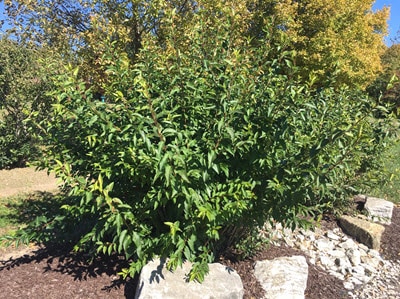
I was over at my neighbors the other day and he was looking at his overgrown forsythia and wondering if it was a good time to prune them back because they had taken over the back bed in his yard. I told him it would have to wait a few months if he wanted them to flower nicely.
When to prune forsythia: Is there a best time to trim them? Forsythia should be pruned or trimmed right after they are finished blooming in the early spring because the flower buds grow on the previous year’s wood (commonly referred to as “old wood”).
The timing of your pruning can make all the difference as to the results you will see later. It is important to time when you trim based on the main goal you are trying to achieve with your forsythia shrub.
Can I prune forsythia at other times of the year is needed?
If you prune forsythia in the summer or fall you are cutting off the stems with all the bloom buds that are set to flower the following spring. By pruning forsythia right after they bloom, early in the growing season, you give the plant time to grow new branches or stems which will have the flowering buds for the following year.
If you are in a situation where you are trying to take control of your forsythia shrubs and it happens to be in the summer or winter, you can prune them anytime it will just affect the number of blooms you will have the following spring.
The earlier in the year that you prune the better because forsythia do need time for cuts to heal and for new growth to harden off for the cold winter, so if you prune later in the summer or fall you might cause some damage to stems that haven’t had enough time to heal and harden off. You are not likely to kill the plant.
Forsythia are in the RHS Pruning Group 2: Early-flowering deciduous shrubs (late winter to late spring). Which just means that forsythia is the type of shrub that produce flowers from last year growth – old wood just like lilacs, weigela, and mock orange. So, if you trim the growth later in a season you are cutting off the stems with all the bloom buds.
How to Shape Forsythia
The best time to trim your forsythia to keep its size or shape is right after it finishes blooming which is in the spring time.
Always remember to prune a shrub back for enough so that when it grows after a few months it will be the actual size you want. For example, if you want the forsythia to be 48 inches tall you will want to make you cuts 10-18 inches below that so that when it grows during the spring and summer it ends up being 48 inches tall.
Forsythia have a natural arch to their stems or branches. If left to grow naturally they will become irregular round shape that is about 10-12 feet tall and wide. That being said you can keep the overall size smaller by regularly pruning forsythia once every year or two.
To keep the overall size smaller always start pruning the older canes or stems which will leave the younger shorter stems. You will want to make the cut as low as you can inside the shrub.
The older stems will have bark that is more of a gray color as opposed to the tan color of newer stems and they will be bigger in diameter.
After you remove about one forth to one third of the older stems then you can simply cut the end remaining longer branches back to a “Y” or “forked branch”. Try not to leave a stub because it will just leave a piece of stem that will die back to the main branch that is left. For a clean and easier cut to heal try to make your cuts at the base of the fork.
To finish shaping the shrub you can simply nip off the wild ends just above a bud.
Tools to Prune Forsythia
You will need up to 3 different hand tools for the different sized stems (canes) and some Isopropyl Alcohol to sterilize the blades between different plants.
Pruning Saw: To cut the older canes close to the ground inside the clump of stems you will normally use a pruning saw because the stems can be well over an inch in diameter. It is also easier to get the tip of the saw blade into the tight spots.
Pro Tip: While cutting with the pruning saw push the part of the branch you are cutting off away from the saw blade so it doesn’t pinch your saw making it harder to push and pull the saw.
Loppers: To make middle plant cuts that are one half inch to almost 1 inch in diameter you can use a lopper. The longer the handles and bigger jaws will give you the leverage you need to make those cuts. Try to push the stem away from the side you are making the cut on to make it easier to cut. It prevents the blade from getting pinched.
Hand Pruners: For any cuts that are three quarters of an inch or smaller you can use a sharp pair of by-pass hand pruners. These are great to do the final shaping of the forsythia bush.
Isopropyl Alcohol: From time to time you will run into branches and plants that have diseases. The best practice to prevent the spread of diseases to other plants in your garden, beds, and landscaping is to clean and disinfect the equipment between using them on different plants.
Where to start forsythia pruning when overgrown or out of control
Step 1: Cut out all the dead stems in the plant no matter the size, to the ground or back to live wood.
Step 2: Once this is done then look for branches that are crossing other branches and remove one
Step 3: Removed any stems that look or have a disease. (remember to sterilize after pruning those stems)
Step 4: Now start taking out the larger, older stems that will be more of a
Step 5: Prune any stems that are growing towards the middle of the plant instead of outward. Usually, you will be making your cuts in the middle of the plant, so make the cuts close to where the branch forks.
Step 6: Finish shaping the plant by trimming the wild or leggy stems back to a fork.
As a general rule you can prune or cut out one fifth (1/5) to one quarter (1/4) of the plant. The more severe you prune the longer it will take for the plant to fill in and reach the desired height. Forsythia in general can handle harder pruning if needed and should recover nicely in 2 seasons.
Rejuvenating Forsythia
Depending on how far you want to take this you can cut the forsythia back to around 4 to 6 inches off the ground. You don’t have to take it to such lengths to rejuvenate the plant. You can choose to remove all the older canes or stems by cutting them out as low as possible – even down to the ground.
Then proceed to cut back other stems by selecting the longest ones first and work you way down in size.
This should be done right after they finish blooming in the spring.
The remaining stems will have bloom buds on them for the next season’s flower show.
Related Questions
Can I Cut My Forsythia To The Ground? Yes, you can cut the forsythia to the ground, but really you want to leave about a 4 to
How Often Should You Trim Forsythia? You should consider trimming a forsythia every year or every other year. If you make it a practice of removing bigger stems and cutting all the normal issues out, like the cross and dead branches once a year you will be rewarded with a well-shaped flowering forsythia every spring that will let you know that winter is losing its grip and summer is just around the corner.
The optimal time to prune forsythia is in the spring just after they have finished blooming. Then follow that up with a little fertilizer and you will enjoy the flower rewards for years to come.
